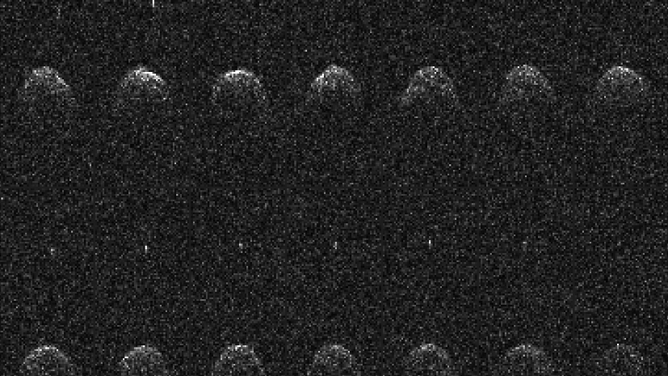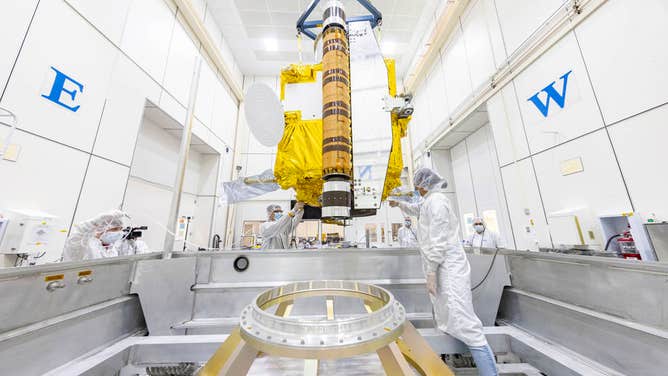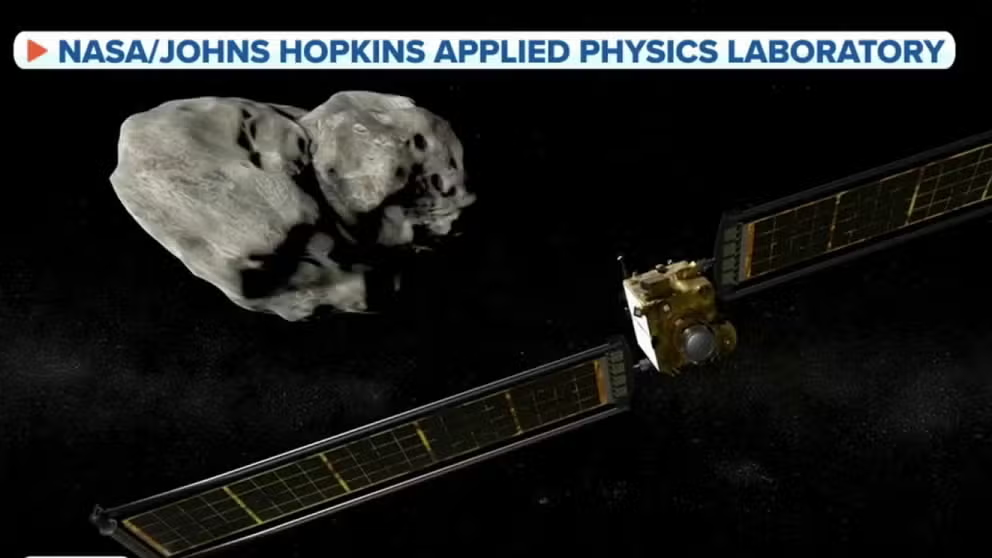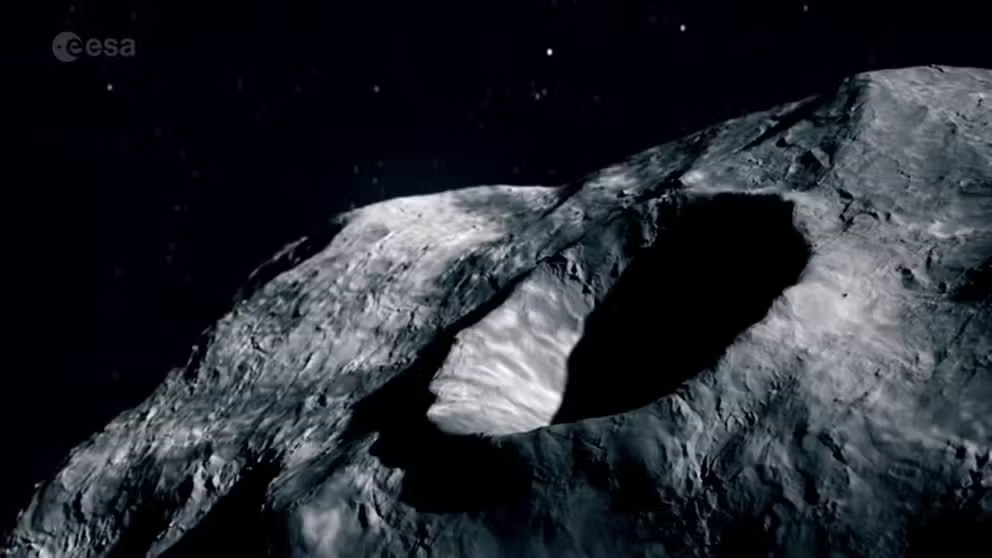NASA slamming a spacecraft into an asteroid is part of an international plan to save Earth
DART's mission will be short-lived but test a critical planetary-defense technique.

Fourteen sequential Arecibo radar images of the near-Earth asteroid Didymos and its moonlet, taken in November 2003.
(NASA)
Most NASA spacecraft or rovers spend years, even decades, conducting science around other worlds. However, longer is not always better in the case of a critical upcoming mission that – if all goes well – will be incredibly short-lived.
A SpaceX Falcon 9 rocket will launch NASA's Double Asteroid Redirect mission known as DART on Nov. 24, from Vandenberg Air Force Base in California. Unlike most NASA spacecraft missions, DART will have a short lifespan.
"A lot of people work on missions and are always trying to justify why they need an extended mission," Johns Hopkins Applied Physics Laboratory Planetary astronomer Andy Rivkin said. "They need more time for their rover on Mars. They need more time for their objects, for their spacecraft orbiting Saturn."
With DART, its team does not want more time. The endgame is the prize.
"If we're still hearing from DART after a particular time … that's not good. We don't want an extended mission," said Rivkin, who is the investigation lead for DART.
That's because, after less than a year in space, NASA plans to use the spacecraft as a battering ram, crashing it into the surface of Dimorphos, a small moonlet of the asteroid called Didymos. The spacecraft is the first robotic mission designed to test an Earth defense plan as part of an international collaboration to protect our planet when an asteroid is headed for a possible collision.
"It is a global concern, and the United Nations plays a part in determining if something were to come, what would happen," Rivkin said.
DART's targets, Didymos and Dimorphos, are not threats to Earth, and according to NASA, no known asteroid larger than 140 meters has a significant chance of crashing into our planet for the next 100 years. However, only about 40 percent of those asteroids have been found as of October.
The DART spacecraft is also carrying LICIACube, a tiny satellite by the Italian Space Agency that will take pictures after DART's demise. Following a quick ending for DART, the European Space Agency mission called HERA will launch two years later, checking out DART's impact to see what happened in detail.
A short life with a big purpose

Inside a cleanroom at Johns Hopkins APL, the DART spacecraft being moved into a specialized shipping container that headed across the country to Vandenberg Space Force Base near Lompoc, California, where DART is scheduled to launch in November 2021. Credits: NASA/Johns Hopkins APL/Ed Whitman
(NASA)
After launch, the spacecraft will catch up to the asteroid in September or October 2022 and complete the test soon after.
DART is about the size of a vending machine with a camera as the only instrument on board. Its primary source of power is the sun. The spacecraft has Roll-Out Solar Arrays that deploy after it's in orbit, expanding the whole spacecraft to about the length of a school bus.
The most crucial part of DART is its mass that will be used to smash into Dimorphos.
Rivkin explained that the spacecraft design was intentionally simple. When there is a need to deflect an asteroid, the world's space programs would likely use an off-the-shelf design instead of creating something new.
About a month ahead of the impending collision, DART's camera will begin sending back images of Didymos.
The camera will feed images to the spacecraft's algorithm to steer the spacecraft as it moves closer to the moonlet. It uses a navigation system called the Small-body Maneuvering Autonomous Real-Time Navigation or SMART Nav to guide itself.
"We're coming in at four miles a second, and so we can't sit there with our controller and our joystick and kind of steer it in," Rivkin said of the navigation system. "The camera will take images. It will send them to the computer. The computer will say, ‘OK, we need to go a little bit to the left. We need to go a little bit to the right’ and take us in and then also send those images back to Earth."
About 8 hours before impact, the team hands over control to the SMART Nav system, as they "pat it on the head and tell it good luck," Rivkin said.
In the final hours, DART selects the impact site and steers itself down. It will continue to send back images until it no longer can, Rivkin said.
A smashing success
NASA DART Spacecraft to Smash Into Asteroid
NASA's spacecraft DART will crash into an asteroid to test a planetary defense theory.
If DART hits Dimorphos at 15,000 mph as planned, this is the best way to test the kinetic impactor Earth defense theory.
"The point of a kinetic impactor is you ram your spacecraft into the asteroid you're worried about, and then you change its orbit around the Sun by doing that," Rivkin said.
DART won't change the orbit of Didymos. It aims to change the speed of the moonlet, Dimorphos. This is because scientists using ground-based telescopes and later another spacecraft will see if it works.
Asteroids move around the Sun at speed of about 20 miles a second. If a kinetic impactor method were used to change its orbit, engineers would only want to alter that by maybe an inch or two a second, a tiny amount, Rivkin explained.
"So to measure that tiny change at this huge speed, it had been thought for a long time that you would need a second spacecraft to sit there and make these really precise measurements," Rivkin said.
That's why Didymos and its moonlet Dimorphos make a perfect practice target. The tiny asteroid orbiting Didymos is moving about a foot per second which is much easier to measure than 20 miles per second.
If this works, the idea is to apply the same technique to larger asteroids. Until this mission, scientists could only simulate such an impact in a lab. DART will give them data to help solidify this defense plan.
Checking DART's homework
Queen guitarist and astrophysicist Brian May explains the HERA mission
The European Space Agency spacecraft HERA will observe the impact left behind from NASA's DART spacecraft.
While DART's mission is over, the cereal-box-sized satellite LICIACube will use its cameras to provide a brief look at the surface of the asteroid.
LICIACube will separate from DART about ten days before impact and fly past Dimorphos about 3 minutes after the crash, according to NASA.
"It gives us more data about that and its structure," Rivkin said. "And then after it passes, it's going to turn around and take a picture of the side of Dimorphos that we didn't get to see because we were on a one-way trip."
DART's team will be looking at how much debris the spacecraft's impact made, how long the debris took to settle, how much escapes the surface, among other questions. All things we need to know before attempting to change the orbit of a potentially hazardous asteroid.
ESA's HERA spacecraft launches in 2024 and will carry a set of CubeSats to go in for a closer look at Didymos and Dimorphos.
Queen guitarist and astrophysicist Brian May explains how HERA will use CubeSats to examine the pair of space rocks in the ESA video above.
Rivkin said they've tried not to get attached to the idea of their spacecraft for the DART team members who have worked for years to make this mission happen.
"It's a tool. The tool is going to do a job," he said. "We put a lot of time and effort into that tool. But, you know, you don't have a favorite nail, you don't have a favorite screw, you use them to do the job."
That job is providing NASA and its international partners with the knowledge to protect Earth.
"Even though the spacecraft itself is going to come to an end, the effort that went into it and the things we've learned is going to be what we take away from it. That's not going anywhere."

